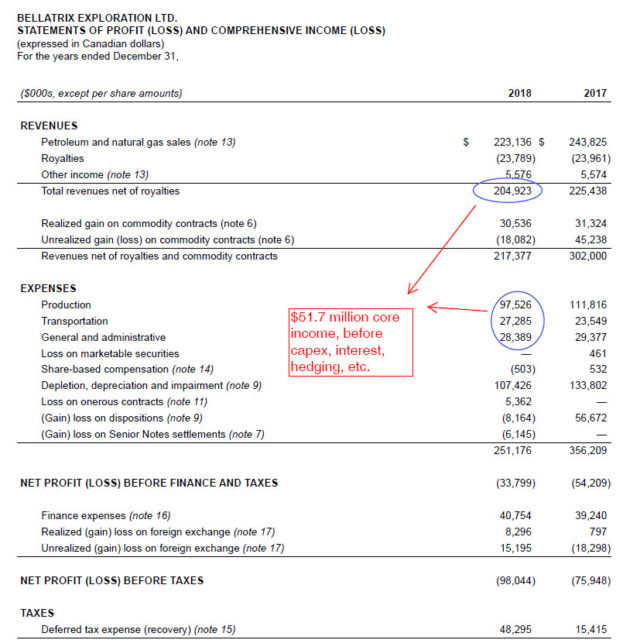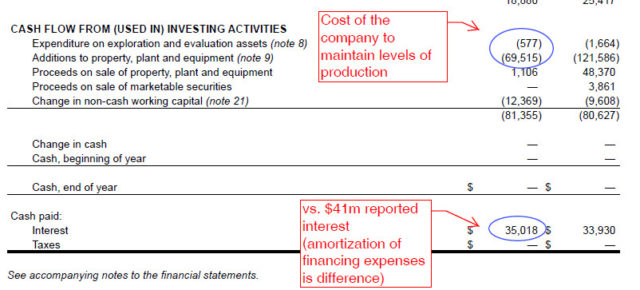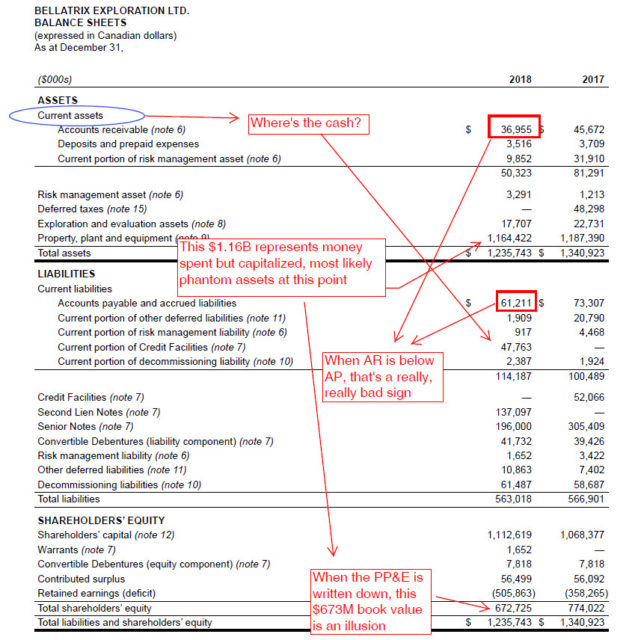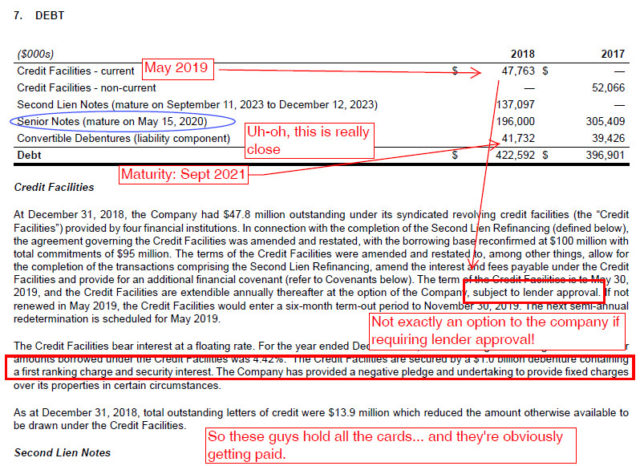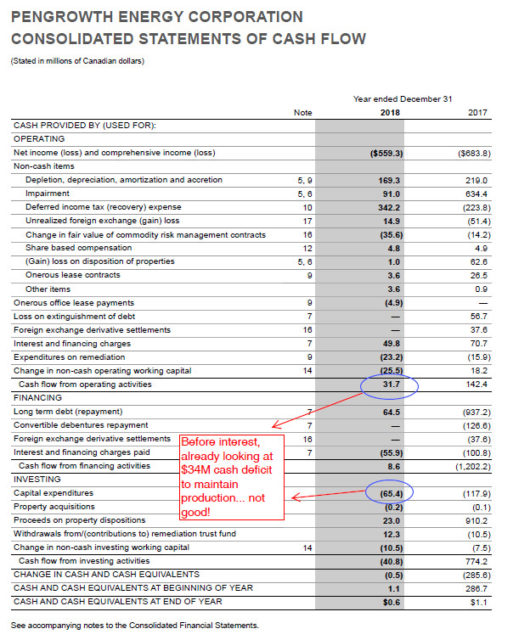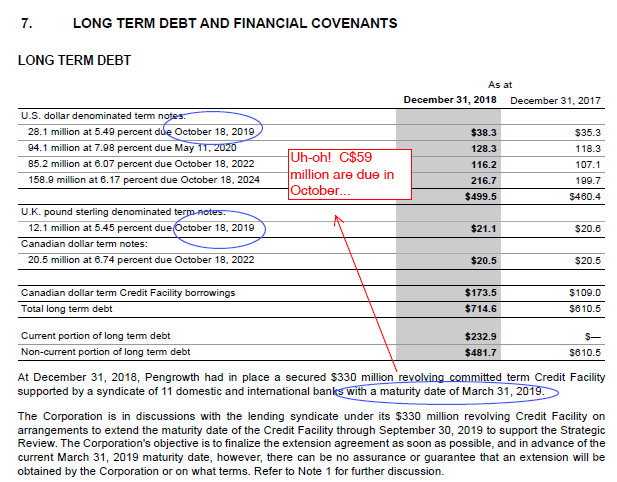Bellatrix Exploration recapitalization
The carnage in the small-to-mid cap Canadian oil and gas sector continues.
Today’s interesting news is the recapitalization proposal of Bellatrix Exploration (TSX: BXE).
In this process, I’ll walk through the financial statements and this will give you a snapshot of how I go through these things. Indeed, this is not exhaustive, but a small part of the thought process.
Readers with exceptionally good long-term memory will know that I had an investment in their debt a very long time ago. Indeed, you can read about a minor exit trading error I made on the investment.
I haven’t touched Bellatrix since (9 years ago!), but still keep track of things. You never know when future opportunity may strike.
Bellatrix, just like most smaller Canadian oil and gas companies, has been really struggling.
From the cash flow statement:
The key 2018 figures include CAD$52 million in EBITDA (not including impact of hedging), but the “I” is $41 million (cash cost is $35) and the “DA” is about $70 million of capital expenditures. People that are untrained at reading financial statements of oil and gas companies will be swayed by the syren’s voice of operating cash flows without due regard in consideration to how much capital expenditure it actually takes to sustain those barrels of oil (equivalent) per day.
In other words, the entity bled about $54 million cash in 2018. Without a change in oil price, the company is going nowhere financially.
On the balance sheet, we note that the company has no cash on hand (cash is provided by a credit facility) and is capitalized by debt financing. This next picture is a gong-show illustration, so forgive me:
This is a company that is in very bad shape on its balance sheet. People that look strictly at financial metrics will see a $672 million book value (shareholder’s equity) and they will say “Hey! That’s over $8/share in value, and with the stock trading at 50 cents that’s a bargain!” but in economic reality, most of that equity value consists of already spent money that takes place in the form of Property, Plant and Equipment – exploration expenses that are capitalized and not expensed. Whether these assets have any recovery value or not depends on economic assumptions of the price of fossil fuels.
The company also has germane issues with its solvency – so we have to dig into the credit facility and debt financing:
We discover the company can borrow up to CAD$95 million and that this facility is first in line, and is up for redetermination at the end of May. This is not a good sign.
The next in line to maturity are the senior notes (which are third ranking, US$145.8 million par outstanding) and this matures in May 15, 2020 (not that far away). The first and second in line creditors will not allow a third-line creditor to jump them in maturity, so this has the makings of a classic credit crunch, which has to be solved. One scenario is that the credit facility provider will choose to extend the timeline another six months to facilitate a recapitalization, but in no way would they ever allow the senior notes to be repaid without huge assurances they would be paid first. Note the second-line noteholders do not have the ability to directly compel BXE to not pay the Senior Notes, but there are covenant issues regarding the loaning of money that is adverse to the interests of the second-line noteholders.
There are other issues regarding covenants which I will ignore for the purposes of this analysis (this adds a layer of complexity which in itself is interesting but I don’t wish to get into this post).
Now we get to the meat of the recapitalization proposal:
* an exchange of all of the Company’s outstanding 8.5% senior unsecured notes due 2020 (the “Senior Unsecured Notes”) for, in the aggregate and taking into account early consent consideration, a combination of US$50 million of new second lien notes due September 2023 (the “New Second Lien Notes”), US$50 million of new third lien notes due December 2023 (the “New Third Lien Notes”) and approximately 51% of the common shares of Bellatrix outstanding immediately following the implementation of the Recapitalization Transaction; and
* an exchange of all of the Company’s outstanding 6.75% convertible debentures due 2021 (the “Convertible Debentures”) for, in the aggregate and taking into account early consent consideration, approximately 32.5% of the common shares of Bellatrix outstanding immediately following the implementation of the Recapitalization Transaction.
…
* it is a condition to completion of the Recapitalization Transaction that the Company’s existing senior bank credit facility (the “Credit Facility”) (which currently matures on November 30, 2019) be extended for a one-year term on terms substantially similar to those currently in place;
The summary is that the company is asking their US$145.8 million senior noteholders to take a US$45.8 million haircut in exchange for 51% of the equity in Bellatrix, and also to become pari-passu (equal standing) to the second-ranking noteholders for US$50 million and effectively extend their own notes for another 3.5 years. The convertible debentures (CAD$50 million par, who are last in line on the pecking order) will receive 32.5% of the equity in Bellatrix.
Existing shareholders will keep 16.5% of the company, in exchange for offloading CAD$50 million plus US$45.8 million in debt, but the company will also receive a term extension on the primary part of its debt until 2023 (when everything becomes due).
The company obtained consent of 90% of the senior note holders (so passage becomes inevitable), but the question then becomes – what if the convertible debenture holders do not agree to this? They received consent from somebody owning 50% of the debentures, but with regards to the other 50%, they cannot be “force consented” unless if a sufficient number of them vote in a class to recapitalize (I am not sure what the threshold amount is).
The debenture holders, if they do not agree, can be told by the company that they will go into CCAA to force the matter (where they will receive nothing in return, instead of the 32.5% equity they are being offered today).
Hence it is interesting that the convertibles are trading up about 10 cents on the dollar today to 60 cents – valuing the remaining equity (plus the encumberance of the second-lien debt and credit facility) at CAD$92 million.
By no means does this recapitalization put Bellatrix on a good financial standing – certainly offloading CAD$111 million in debt will be good for the company, but the underlying operations still need an assist on the price of oil. If this recapitalization does go through, there are still considerable headwinds to be faced.
Mistakes in investing – a couple examples
I’m going to reciprocate Tyler’s mention of a previous post of mine, and give him due credit for the following: My Biggest Mistakes.
There are mistakes of commission and mistakes of omission.
The idea is when you make mistakes of commission (and they will happen), is to quickly recognize them, take losses, and move on. Ideally the losses can be kept relatively small (let’s define this as 0-20% of the original investment) instead of them developing into 40-50% losses.
Simple math illustrates why avoiding large losses are desirable: If you take a 10% loss, you need an 11% gainer to break even. If you take a 20% loss, you need a 25% gainer to break even. If you lose half, you’ll need something to double. Suffice to say, finding something that will double in the future is a lot more difficult than finding something that’ll appreciate 25%.
When looking over my track record, the types of mistakes that I have made over the past half decade or so have typically been ones of omission. Not buying IRobot (Nasdaq: IRBT) at the end of 2015 is something I am still kicking myself for. I usually require significant margins of error before pulling the trigger, and also I typically have cash allocations that are well above what a normal portfolio should have. Including my components of preferred shares (which are invested in companies that are predictably stable and are in zero danger of suspending such preferred share dividends, and have improving credit profiles), one could fault my investment style for not performing well enough – if I have a quarter allocation of cash and I can continue to generate double-digit percent returns, why shouldn’t I just spread the cash in the existing portfolio components?
Psychologically, I need to sleep well at night, and cash allows me to do this.
My biggest mistake of commission, by far, was in IMRIS, a medical imaging company. The original investment was back in 2012.
Medical imaging has a lot of barriers to entry. There is a chicken-and-egg problem: hospitals don’t want to deal with small providers because there are issues with support and maintenance. In addition, procedures and the “soft” side (training, hospital administration in line, etc.) has to all be in order.
The thesis, condensed: IMRIS had an innovative product (a movable MRI machine) that, from my research and knowledge about medical imaging, was actually useful. They had successful installations in various hospitals around the world, and they were starting to build the critical mass of credibility needed to make it through the next inflection point where they would hit the big time (or get bought out by a major such as McKesson, Siemens, GE, etc.). They had a significant shareholder (which presumably would not let the company go under).
They made a strategic decision to relocate their corporate headquarters from Winnipeg to Minneapolis, for the reason that it would be easier to procure US capital investment. This should have been a huge warning sign (an international corporate relocation is going to cause huge disruption to the operations of the business and I should have bailed out the nanosecond I read this) but I thought the other factors were too compelling.
Each quarter, management was promising they were on the cusp of this breakthrough, and each quarter, the financial results coming in were sub-par. Eventually, they ran out of money and had to agree to a debt financing arrangement in September 2013. The terms were quite onerous and I knew the game was up, and sold out for a very significant loss.
A couple years later they filed for bankruptcy protection. I would have lost everything had I held on.
The business itself turned out reasonably well for its new (private) owners. According to a 2017 press release, they obtained record revenue growth and bookings. Obviously one can’t see the financial statements of this now private entity, but I think the original investment thesis was valid – just that they ran out of money, which happens in these types of ventures which have long lead times with unpredictable sales funnels.
I was looking for an Intuitive Surgical (Nasdaq: ISRG) situation where they managed to reach that inflection point of critical mass, and once that happens, you achieve very large investment returns. ISRG is another example of an error of omission.
Going back even further, one of my most embarrassing losses was losing a moderate amount of capital on an investment in the debentures of Sterling Shoes. They declared bankruptcy in 2011. I just barely managed to unload my debentures (for around 20 cents on the dollar) before they filed for CCAA protection. This was simply an instance of me not understanding anything about the dynamics of the retail market they were engaged in – this was an error of pure incompetence.
Admitting mistakes, continuously looking for information that will dispel your investment thesis, and rectifying the situation as quickly as possible are traits of good investors. Investors that aren’t able to elaborate on mistakes they have made in the past are likely doing themselves a disservice.
Tobacco vs. Marijuana
This headline passed by my radar: Japan Tobacco Wins Court Protection in Canada Over Smoking.
In both US and Canadian jurisdictions, governments have been engaging tobacco companies in civil litigation over the undisclosed risks of smoking. The majority of drama settled in the late 90’s in the USA, but things in Canada have taken longer.
According to the article:
The lawsuits were in favor of smokers seeking damages for addiction and smoking-related diseases, who argued they were never warned of the risks.
There are no longer any Canadian publicly traded companies that deal with the tobacco industry, although you can invest in Philip Morris (most associated with the Marlborough brand) in the USA.
However, this gets me thinking – 20 years down the line, when rampant consumption of marijuana is determined to be a cause of the breakdown of the brain’s normal functioning in older age, will governments decide to go after marijuana companies for not disclosing this hitherto undisclosed risk of consuming too much THC? What about second-hand smoke, which is more abundant than ever on the streets now that marijuana is legalized?
I try not to allow politics or morals interfere with objective investment analysis, but the double standard that is applied between tobacco and marijuana is amusing, to say the least. When marijuana is no longer in favour, watch out!
Pengrowth is hitting the financial wall
Pengrowth Energy (TSX: PGF) is an entity I have been following for a very long time. I used to own their debentures, which matured at par a few years ago. Today, their financial situation is much more dire and from their annual report (released today), we glean the following:
Suffering from low prices and high capital costs, the company is still bleeding money. In addition, when looking at their balance sheet:
This is not a happy situation. Although management is “positive” they can strike a new credit agreement by the end of this month (when their secured credit facility becomes due), every bank in this syndicate will see CAD$59 million going out the window in October and another CAD$128 million going out eight months later. Considering the banks are the senior secured creditors in this arrangement, I very much doubt they will be willing to extend credit to the point where the October 2019 noteholders will be paid.
There is also the issue of the covenant, where the interest coverage ratio for Q4-2019 has to be better than 4.0, while presently (for the 2018 calendar year) such ratio was 1.6 – barring a huge increase in oil prices in the remainder of this calendar year, PGF stands no chance of meeting this covenant, which applies to both bank debt and notes.
PGF is going to have to negotiate immediately with their secured creditors a 6 month extension (which is currently what they disclosed) but during this six month period will have to negotiate with noteholders and the banks alike to come to a consolidated credit agreement. This is not going to be easy. In other words, we have a credit crunch.
The stock took a nose dive from 73 cents down to 51 cents in today’s trading, but has somehow managed to recover to the 74 cent level despite this news, which I found very fascinating.
The only real wildcard in this entire matter is (billionaire and former large Canadian Oil Sands investor that opposed the merger with Suncor) Seymour Schulich’s huge equity stake in the entity, owning about 29% of the company. Will he bail them out before the banks decide to take the entire firm for themselves?
